Physical Address
304 North Cardinal St.
Dorchester Center, MA 02124
Although anterior vaginal prolapse is most common, loss of apical support is usually present in women with prolapse that extends beyond the hymen. There is growing recognition that adequate support for the vaginal apex is an essential component of a durable surgical repair for women with advanced prolapse ( ; ). At least half of the observed variation in anterior compartment support may be explained by apical support ( ). Because of the significant contribution of the apex to anterior vaginal support, the best surgical correction of the anterior and posterior walls may fail unless the apex is adequately supported. Recognition of apical defects is one of the biggest challenges in the preoperative evaluation of pelvic support defects; however, surgical correction of the apex has several good options with relatively high success rates. Apical suspension procedures can broadly be separated into those performed tranvaginally and those performed abdominally. Abdominal procedures can be performed via laparotomy or using conventional laparoscopic or robotically-assisted laparoscopic techniques. Although precise estimates are not available, most studies suggest that the vaginal approach is most common with over 80% of procedures using this approach. This chapter reviews the indications, surgical techniques, outcomes, and complications associated with a variety of apical support procedures performed vaginally or abdominally, often through minimally invasive techniques.
The vaginal axis in an erect woman normally is nearly horizontal in the upper half of the vagina, with the uterus and upper 3 to 4 cm of the vagina lying over the levator plate in the hollow of the sacrum ( Fig. 21.1 ). found that the vagina is directed toward the S3 and S4 vertebrae and extends approximately 3 cm past the ischial spines in most nulliparous women. Distortion of the normal vaginal axis during reconstructive pelvic surgery predisposes women to the development of pelvic organ prolapse at an anatomic site opposite to where the repair was performed. Examples of this are the development of posterior vaginal wall prolapse after colposuspension procedures for stress incontinence and the development of anterior vaginal wall prolapse after suspension of the vaginal apex to the sacrospinous ligament.
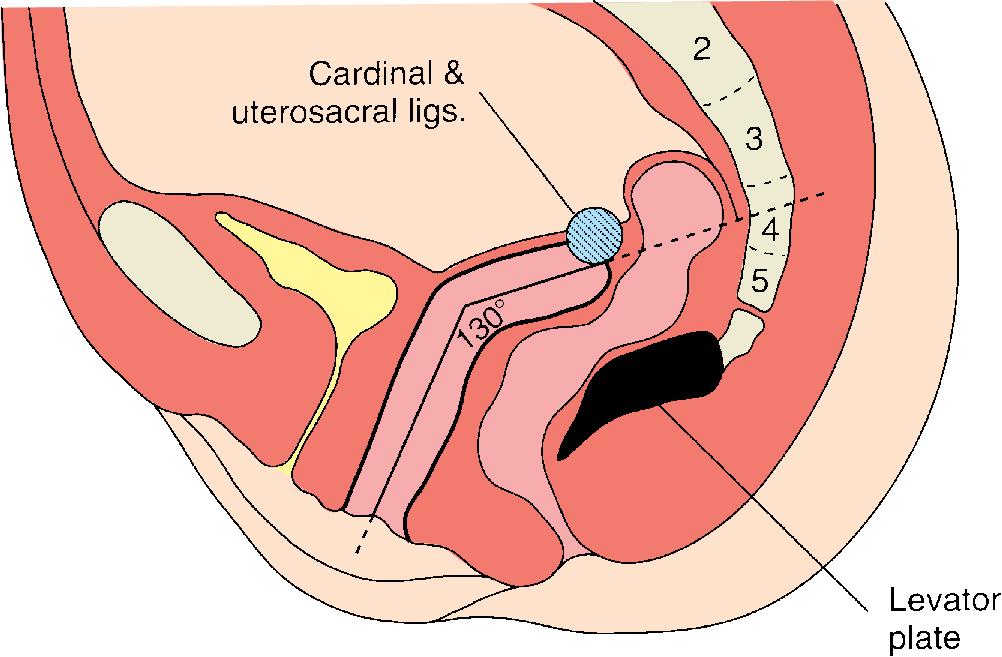
When planning an effective surgical approach to pelvic organ prolapse, a surgeon must keep in mind the three levels of support of the vagina. The proximal or upper fourth of the vagina (level I) is suspended by the cardinal/uterosacral complex, the middle half (level II) is attached laterally to the arcus tendineus fasciae pelvis and the medial aspect of the levator ani muscles, and the distal or lower fourth (level III) is fused to the perineal body. See Chapter 1 for more details. The goals of pelvic reconstructive surgery are to correct all defects, thus reestablishing vaginal support at all three levels, and to maintain or restore normal visceral and sexual function.
The uterosacral ligament suspension (ULS) and sacrospinous ligament suspension (SSLS) are the two most common and widely studied transvaginal native tissue vaginal apical procedures. The iliococcygeus suspension offers an alternative vaginal extraperitoneal approach that can be useful in women with foreshortened vaginas and/or apical-posterior prolapse.
A popular transvaginal approach to the management of apical prolapse is bilateral ULS. This approach was first described by Miller in 1927 and later popularized by Shull in the late 1990s ( ; ). The ULS suspends the vaginal apex to the proximal remnants of the uterosacral ligaments using an intraperitoneal surgical approach. This procedure restores the vagina to its normal axis, avoiding the retroflexion that is associated with the SSLS. The procedure requires intraperitoneal access and can be easily accomplished at the time of a vaginal hysterectomy to treat concurrent uterine/apical prolapse. The location of the sutures along the uterosacral ligament can be tailored to the amount of prolapse present, with more advanced amounts of prolapse requiring higher placement of sutures ( Fig. 21.2 ). Whereas surgeons frequently “reattach” the distal uterosacral ligaments to the vaginal cuff with the intention of preventing future prolapse, a ULS performed to treat prolapse of the apex includes sutures placed proximal to the level of the ischial spines. The procedure suspends the apex of the vagina into the hollow of the sacrum and thus maintains the midline orientation of the vaginal axis. A ULS procedure can be performed abdominally or laparoscopically, but the transvaginal route is most common. The technique for the intraperitoneal transvaginal approach is described below. Also, ![]() provides a description of the surgical anatomy and steps of the ULS.
provides a description of the surgical anatomy and steps of the ULS.
The peritoneal cavity has already been accessed if performed after a vaginal hysterectomy. For vaginal vault prolapse, the vaginal apex is grasped with two Allis clamps ( Fig. 21.3 A) and incised with a scalpel. The vaginal epithelium is dissected off the enterocele sac, the enterocele is opened, and the hernia sac is excised ( Fig. 21.3 B). See ![]() for a demonstration of techniques for vaginal entry into the peritoneal cavity in posthysterectomy prolapse patients. If intraperitoneal access cannot be obtained, we prefer to proceed with a sacrospinous suspension.
for a demonstration of techniques for vaginal entry into the peritoneal cavity in posthysterectomy prolapse patients. If intraperitoneal access cannot be obtained, we prefer to proceed with a sacrospinous suspension.
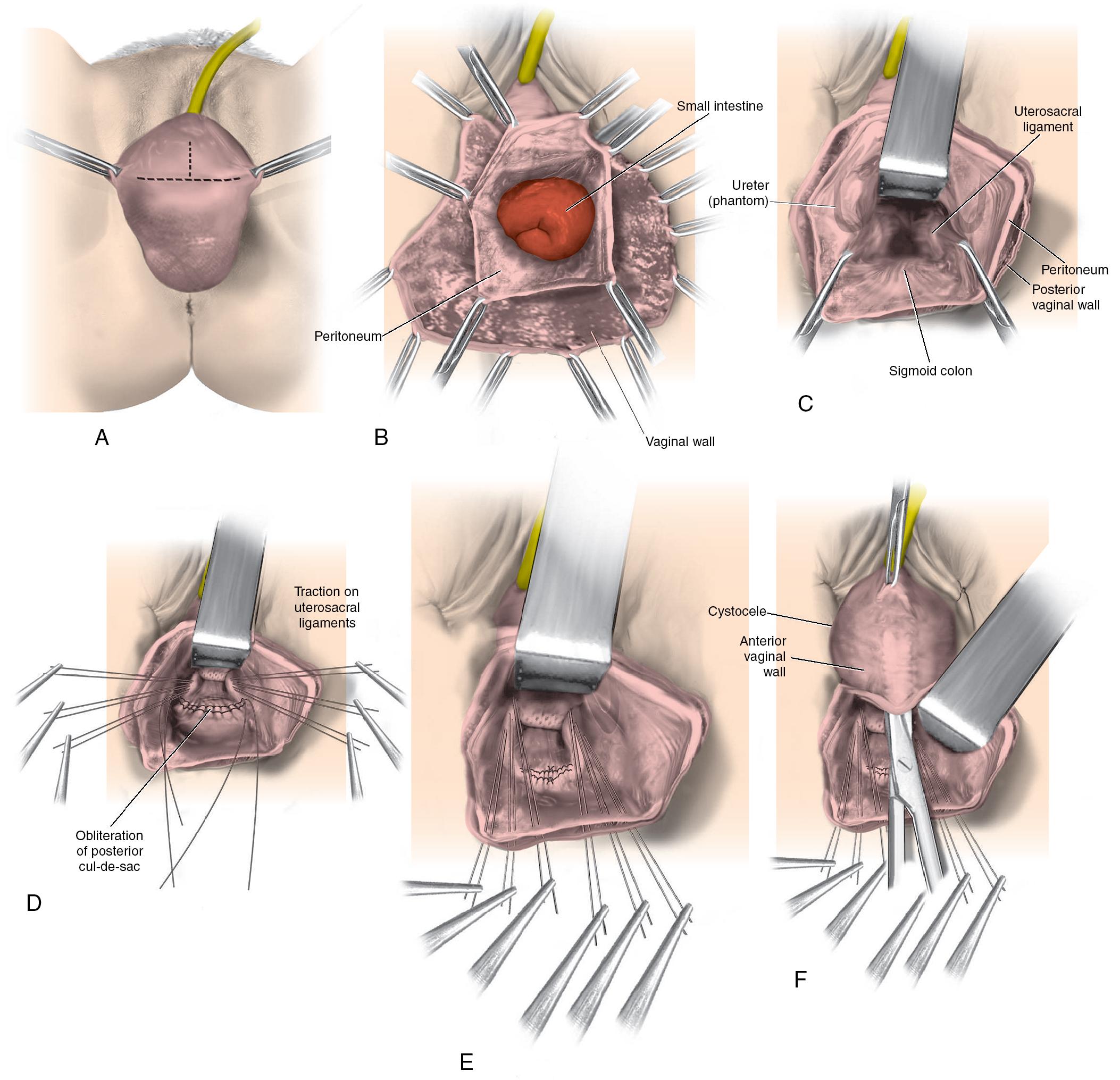
Several moist tail sponges are placed in the posterior cul-de-sac. A wide Deaver retractor is used to elevate the packs and the intestines out of the operative field. A Breisky–Navratil detractor is often a valuable tool.
The ischial spines are palpated transperitoneally. The remnants of the uterosacral ligaments are found posterior and medial to the ischial spine, and the ureter can sometimes be palpated or visualized along the pelvic side wall, anywhere from 2 to 5 cm ventral and lateral to the ischial spine.
Traction on long Allis clamps placed at approximately the 5 o’clock and 7 o’clock positions allows palpation of the uterosacral ligament complex ( Fig. 21.3 C).
Usually, two to three delayed absorbable sutures are passed through the ligament on each side. Some prefer a combination of delayed absorbable and permanent sutures. To ensure adequate vaginal suspension, the highest (most proximal) suture should be 1 to 3 cm proximal to the level of the ischial spine ( Fig. 21.3 D). We have found that grasping the proximal uterosacral ligament at the position where the suspension sutures will be placed facilitates placement and minimizes the risk of entrapping underlying structures like nerves ( Fig. 21.4 A–C).
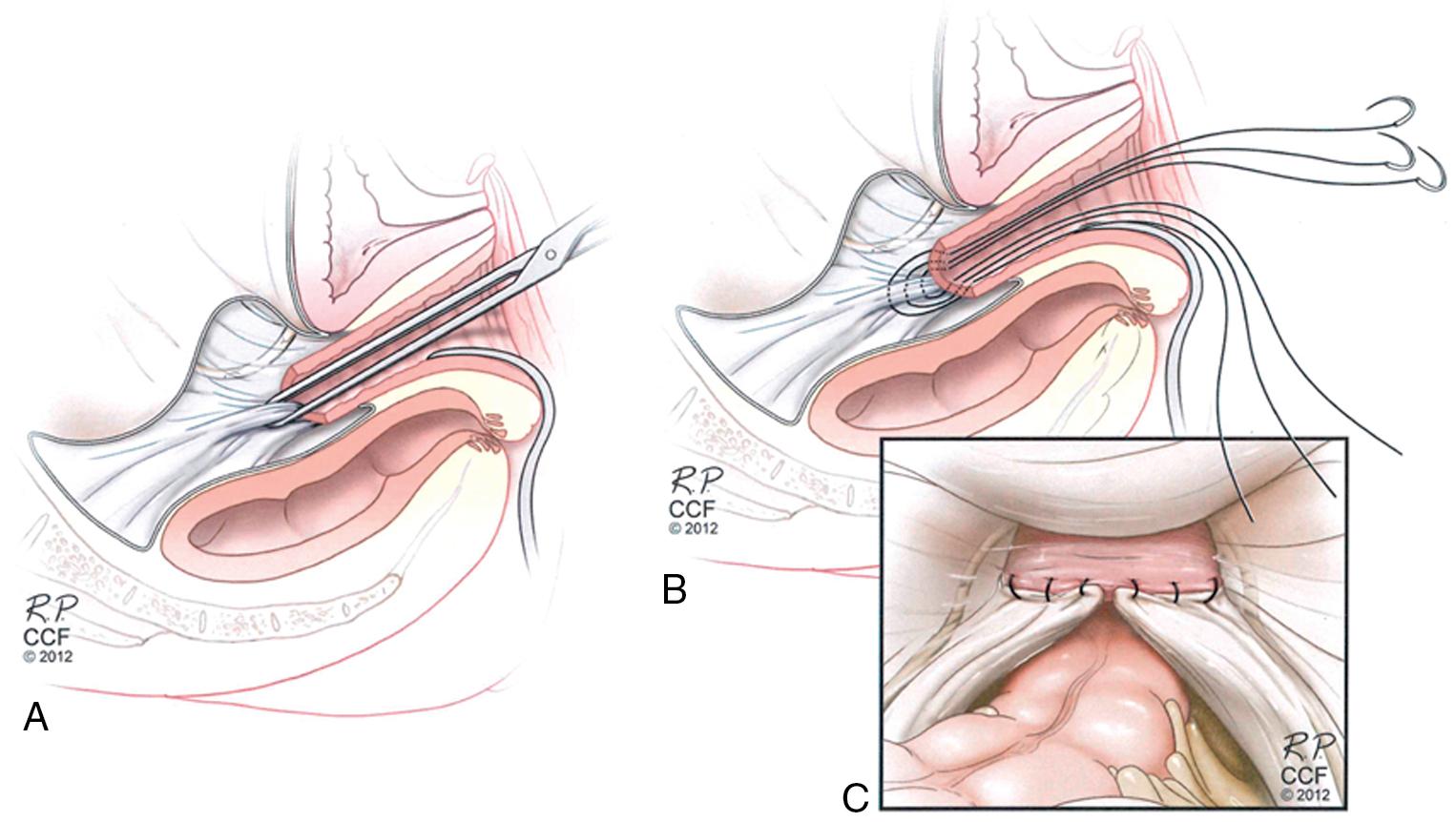
The delayed absorbable sutures that had been passed high up through the uterosacral ligaments then are passed either through the full thickness of the posterior vaginal wall ( Fig. 21.3 E) or, as is our usual practice, through the full thickness of both the anterior and posterior vaginal walls ( Fig 21.4 B). To assess ureteral patency we place the uterosacral sutures under moderate tension and perform cystoscopy after administration of intravenous indigo carmine. If ureteral spill is not present on either side, the suture can easily be replaced, typically more medially, and cystoscopy repeated until bilateral ureteral patency is confirmed. Cystoscopy can also be performed at the end of the procedure, but should be performed concomitantly given the risk of ureteral stricture.
If necessary, an anterior colporrhaphy or posterior colporrhaphy can be performed. The vagina is trimmed and closed with a No. 3-0 delayed absorbable suture ( Fig. 21.3 F and G).
Next, the vault suspension sutures are tied elevating the vagina high up into the hollow of the sacrum ( Fig. 21.3 H).
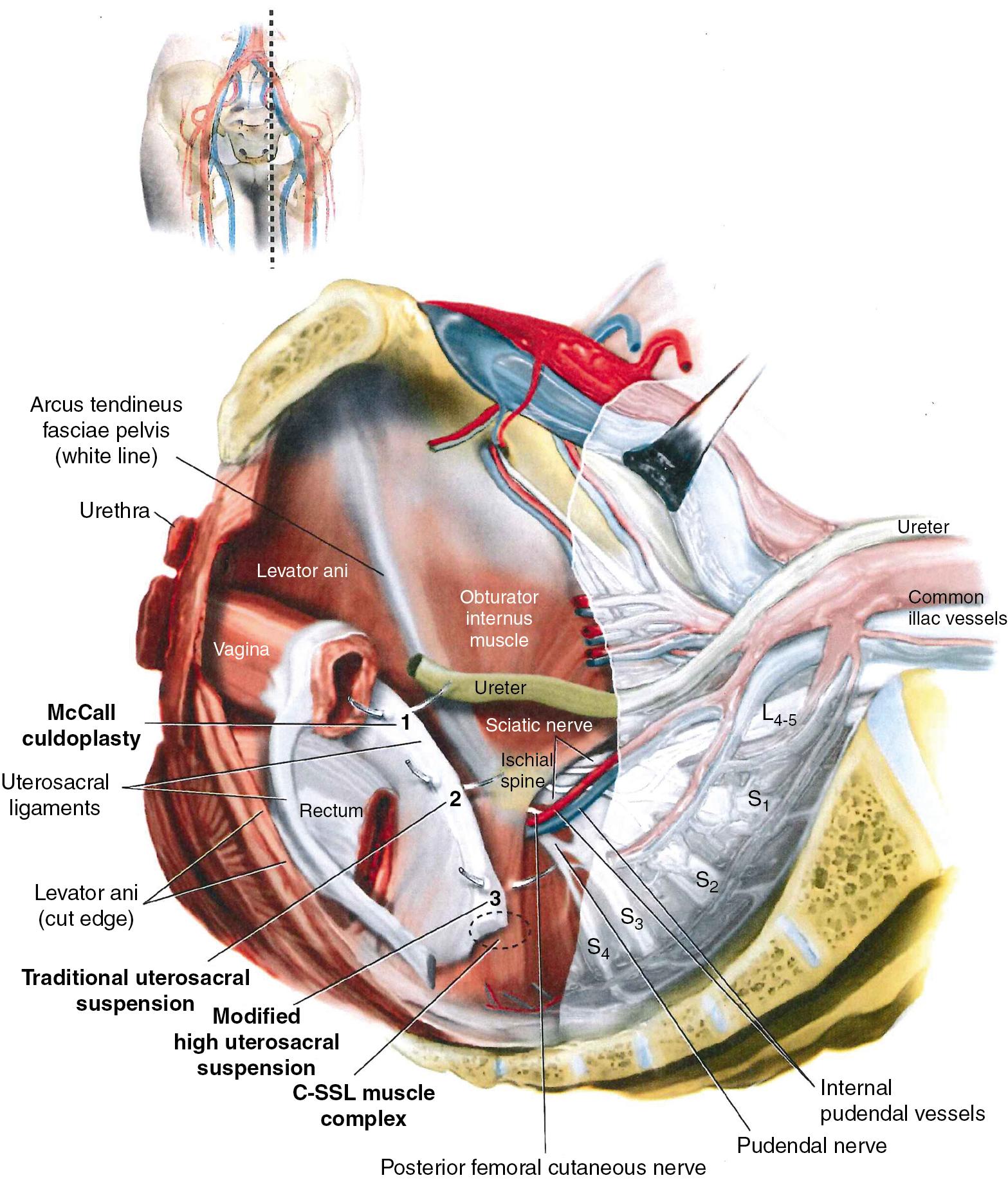
With the exception of the Operations and Pelvic Muscle Training in the Management of Apical Support Loss (OPTIMAL) trial ( ), the current evidence supporting the use of ULS is limited primarily to uncontrolled cohorts or case series, and evaluation of these data suggest a mean objective success rate of 85% (range 48%–96%) and mean reoperation rate for prolapse of 5.8% (range 0%–12%) ( ). A metaanalysis performed by found pooled rates of anatomic success (Pelvic Organ Prolapse Quantification [POPQ] stage 0–1) of 81.2% (95% confidence interval [CI] 67.5–94.5) for the anterior segment, 98.3% (95% CI 95.7–100) for the apical segment, and 87.4% (95% CI, 67.5–94.5) for the posterior segment. Postoperative prolapse symptoms were relieved in 82% to 100% of patients. These promising results are balanced by ureteral kinking/injury rate of 4% to 6%. A review of 700 consecutive vaginal prolapse surgeries found intraoperative ureteral kinking/injury in 5.9% of patients that was directly attributable to ULS. However, 87% of these cases of ureteral kinking/injury were identified at cystoscopy before the completion of the index surgery and were relieved by removing suspension sutures intraoperatively, with no long-term consequence to the patient ( ). Only three of 355 ULS procedures (0.9%) performed in this series required additional procedures to relieve or correct ureteral obstruction or injury. A retrospective review of over 900 patients receiving ULS found an overall adverse event rate of 31.2%, with 20.3% being attributed to postoperative urinary tract infection ( ). Rates of pulmonary and cardiac events were 2.3%, whereas the rate of ileus and small bowel obstruction (SBO) was less than 0.5%. The intraoperative bladder injury rate was 1%. There were no intraoperative ureteral injuries; however, 4.5% of cases were complicated by ureteral kinking, all of which were resolved without subsequent sequelae by intraoperative suture removal with or without replacement of the vault suspension stitches. identified 10 studies including a total of 820 women that reported on perioperative complications of ULS. The ureteral reimplantation rate in this series was only 0.6%. Blood transfusions were reported in 1.3%, cystotomy in 0.1%, and bowel injury in 0.2%.
Abdominal and laparoscopic ULS techniques have also been described. reported a retrospective review of 107 women who underwent prolapse surgery that included an abdominal ULS. In the 75 patients who completed 1-year follow-up, 12% reported recurrent or persistent prolapse symptoms, and 7% had an anatomic failure (POPQ stage 2 or greater). Complications were relatively few; however, exposure of the apical sutures (expanded polytetrafluorethylene) occurred in 9% at an average of 56 months postsurgery (range 3–75 months). Two retrospective comparisons between vaginal and laparoscopic ULS procedures found no significant difference in perioperative morbidity or anatomic or subjective outcomes ( ; ).
One of the most popular and widely reported native tissue transvaginal procedures for correcting apical prolapse is the SSLS. First described in 1958, this procedure suspends the vaginal apex to the sacrospinous ligament either unilaterally or bilaterally, typically using an extraperitoneal approach ( ). The SSLS is often performed for moderate to severe apical uterine prolapse or for vaginal vault prolapse after hysterectomy. To perform SSLS, the surgeon must be familiar with pararectal anatomy, as well as the anatomy of the ischial spine, ileococcygeus and coccygeus muscles, sacrospinous ligament, and the surrounding structures ( Fig. 21.5 ). The sacrospinous ligaments extend from the ischial spines on each side to the lower portion of the sacrum and coccyx. The fibromuscular coccygeus muscle closely overlies the sacrospinous ligament, and thus these structures are often referred to as the sacrospinous ligament complex (C-SSL). We usually perform the apical suspension unilateral to the right C-SSL, but surgeons occasionally use the left C-SSL or perform a bilateral suspension. The C-SSL is identified by palpating the ischial spine and tracing the flat triangular thickening medial and posterior to the sacrum. The pudendal nerves and vessels lie directly posterior to the ischial spine. The sciatic nerve lies superior and lateral to the C-SSL. Also, an abundant vascular supply that includes inferior gluteal vessels and hypogastric venous plexus lies superiorly.
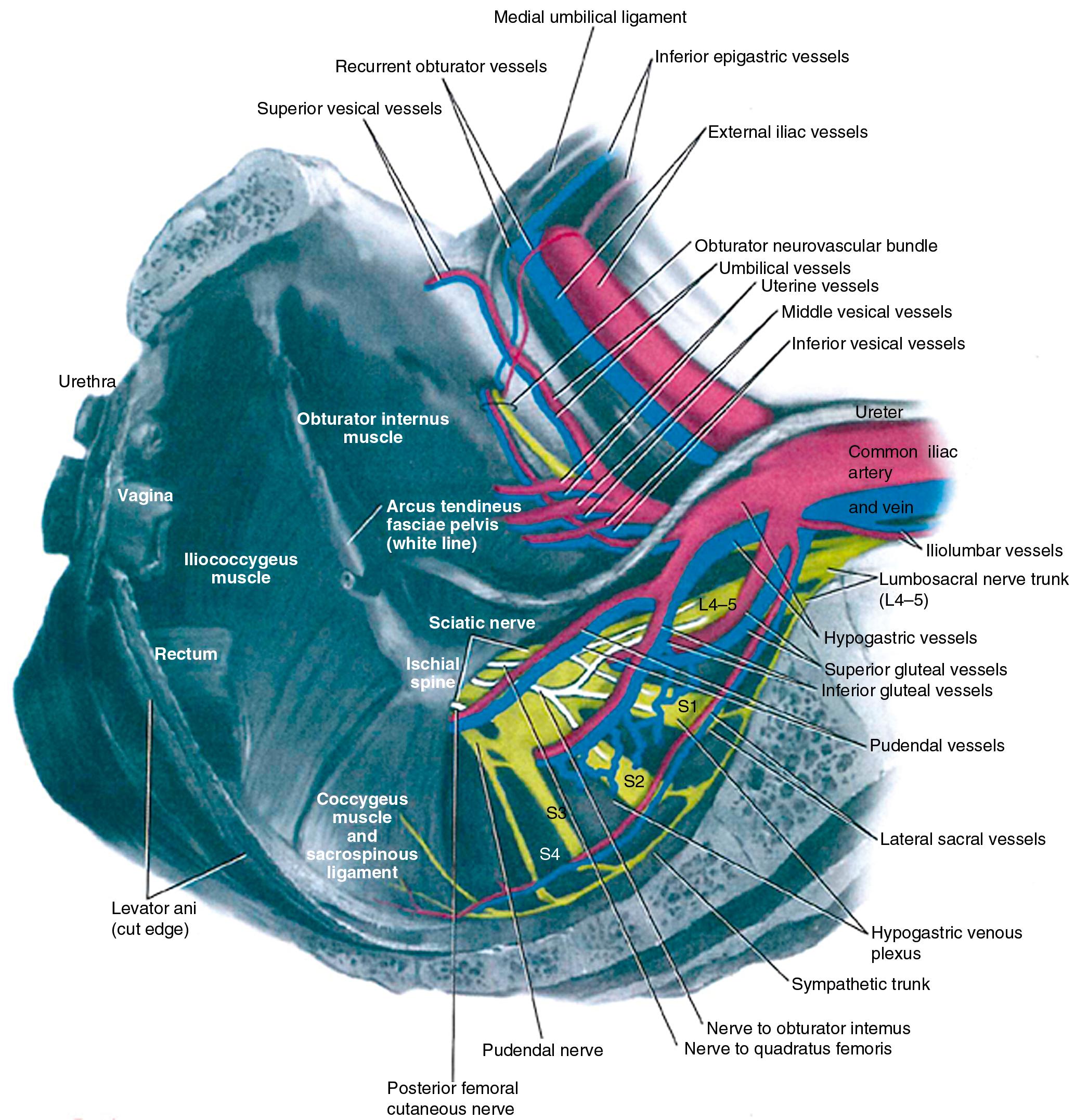
The ischial spines and C-SSL should be palpated preoperatively during pelvic examination. This operation usually requires simultaneous correction of the anterior and posterior vaginal walls and an enterocele repair. Placing the prolapsed vaginal apex to the sacrospinous ligament to see whether the vagina is long enough to complete the repair and whether the anterior and posterior vaginal wall prolapse is corrected by apical suspension helps to determine whether cystocele and rectocele repairs are needed. Patient consent to these possible repairs should be routinely obtained, because it is frequently difficult to discern the extent of the various defects in the office. The technique of unilateral SSLS is described below. Also, see ![]() for a demonstration of the procedure.
for a demonstration of the procedure.
If the uterus is present, a vaginal hysterectomy is done, and the peritoneum is closed, as previously described. Sacrospinous cervicopexy or hysteropexy could also be done using similar technique, if desired. (See Chapter 22 .)
The apex of the vagina is grasped with two Allis clamps, and downward traction is used to determine the extent of the vaginal prolapse and associated vaginal support defects. The vaginal apex then is reduced to the sacrospinous ligament intended to be used. At times the true apex of the vagina at the hysterectomy scar is foreshortened and will not reach the intended area of fixation, as with a shortened anterior vaginal wall and a prominent posterior enterocele. The “new” apex should be moved to a portion of the vaginal wall over the most severe prolapse, thus allowing sufficient vaginal length for suspension to the C-SSL and the even and optimal suspension of the anterior and posterior vaginal walls. The intended apex is tagged with two sutures for later identification.
The C-SSL can be accessed via a posterior vaginal dissection, through the apex, or by an anterior approach dissecting at the base of a paravaginal dissection. In the posterior approach a proximal midline posterior vaginal wall incision is made just short of the apex of the vagina, leaving a small vaginal bridge approximately 3 or 4 cm wide. If an enterocele sac is encountered, it is dissected off the rectum and posterior vaginal wall and apex and closed with a high purse string suture.
The pararectal space or the space along the peritoneum near the apex then is entered by breaking through the fibroareolar tissue just lateral to the enterocele sac at the level of the ischial spine. This can usually be accomplished with blunt dissection after mobilizing the rectum medially. At times, however, the use of gauze on the index finger or a tonsil clamp is necessary to break into this space.
Once the pararectal space is entered, the ischial spine is identified, and, with dorsal and medial movement of the fingers, the C-SSL is palpated. Blunt dissection is used to further remove tissue from this area. The surgeon should take great care to ensure that the rectum is adequately retracted medially. At this time, we recommend performing a rectal examination to ensure that no inadvertent rectal injury has occurred.
Several techniques are used for the actual passage of sutures through the ligament. Our preferred technique for passing the sutures through the C-SSL uses a device that places and captures transvaginal sutures ( Fig. 21.6 A). This technique is safer and easier than other techniques because the device enters the C-SSL under direct palpation of distinct landmarks, proceeding top to bottom, and then is pulled down into the safe pararectal space below. Alternative options for placing the C-SSL sutures are the long-handled Deschamps ligature carrier and nerve hook, the Miya hook, and even direct suturing. To perform this technique on the right, the left middle or index fingertip is placed on the C-SSL just below its superior margin, approximately 2 to 3 cm medial to the ischial spine or in the midposition of the C-SSL. A long retractor such as a Briesky–Navratil retractor can be placed medially to mobilize and protect the rectum if needed. Great care should be taken when dissecting and retracting in this area to prevent bleeding, as well as nerve and rectal damage. The suture-capturing device, held in the right hand in a closed position, is slid along the palmar surface of the left hand. With the tip of the middle finger, the suture-capturing device notch is placed 2 to 3 cm medial to the ischial spine, approximately 0.5 cm below the superior edge. With the middle and index fingers, firm downward pressure is applied, and the device is engaged at the handle, so the needle passer penetrates the C-SSL ( Fig. 21.6 A). The handle is released, the device is removed with the suture, and the suture is tagged. Depending on the size of the ligament, most surgeons place between two and four sutures through the C-SSL to attach it to the vaginal apex ( Fig. 21.6 B). There is no consensus about suture type; a combination of delayed absorbable and nonabsorbable monofilament sutures is commonly used.
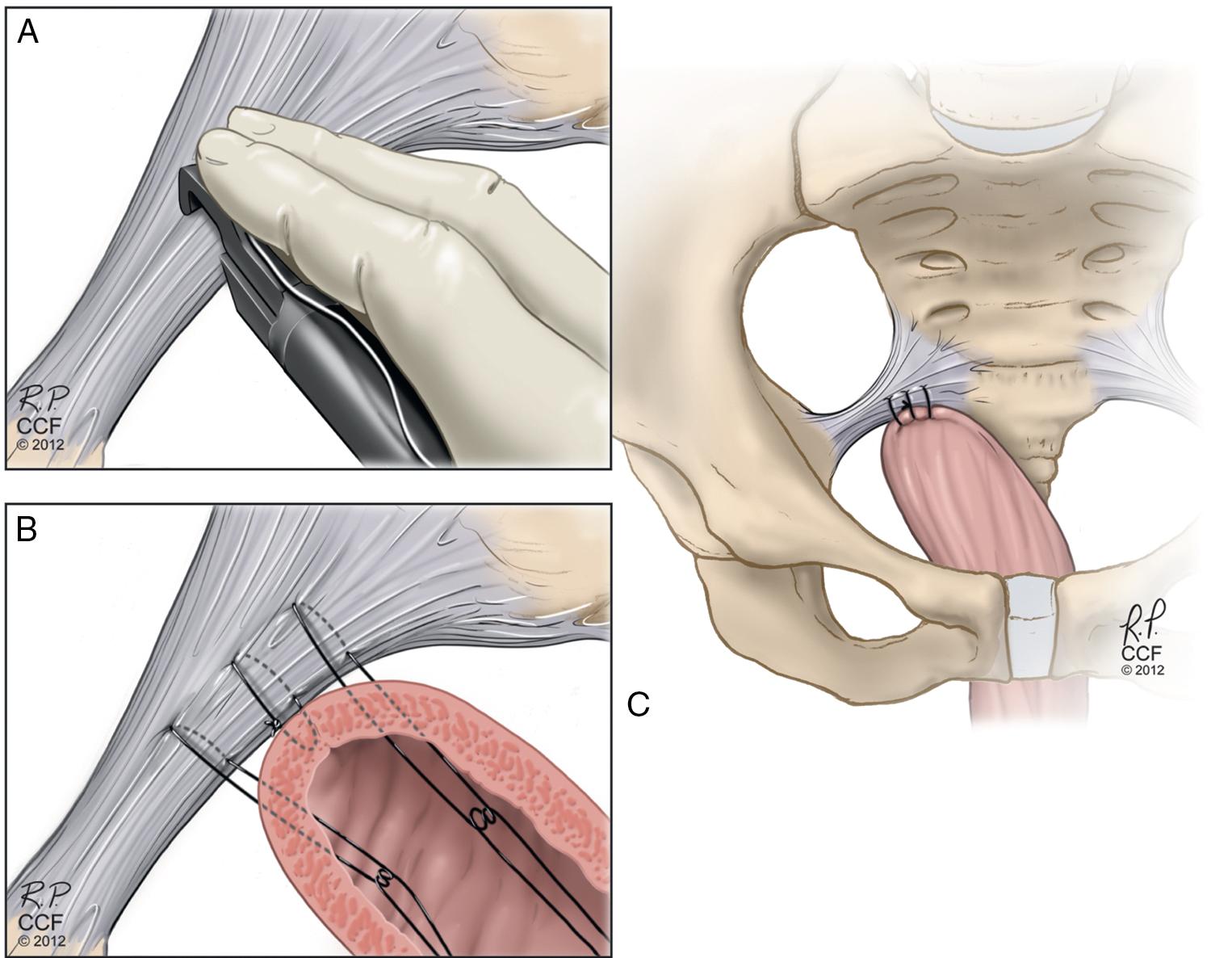
If the patient requires an anterior vaginal wall repair, we prefer performing an anterior colporrhaphy at this point in the operation and before tying the apical support sutures.
The surgeon then brings the stitches out to the apex of the vagina, either with the use of a pulley stitch for permanent sutures or by simply passing each pair of sutures through the apex for delayed absorbable sutures ( Fig. 21.6 B). After the sutures have been brought out through the vagina, the upper portion of the posterior vaginal wall is closed with continuous absorbable No. 2-0 sutures. The vaginal apex suspension stitches then are tied, thus elevating the apex of the vagina to the C-SSL ( Fig. 21.6 C). It is important that the vagina comes into contact with the C-SSL and that no suture bridge exists, especially if delayed absorbable sutures are being used. While tying these sutures, it may be useful to perform a rectal examination to detect any suture bridges.
After these sutures are tied, an anti-incontinence procedure and a posterior colpoperineorrhaphy are completed, as needed. The vagina can be packed with moist gauze for 24 hours, if desired.
The risk of ureteral obstruction or kinking is extremely low with sacrospinous ligament fixation. However, we still recommend cystourethroscopy, particularly if a concomitant enterocele repair, anterior colporrhaphy, or anti-incontinence procedure is performed, to confirm ureteral patency and absence of suture in the bladder.
Observational series and clinical trials suggest that, while apical recurrence after SSLS is uncommon (0.6%–19%), recurrence of anterior vaginal prolapse is more problematic (3.7%–28.5%) ( ). A meta-analysis by found an overall failure rate at any site of 28.8% (95% CI 18.4–36.3) with failure of the anterior segment seen in 21.3% (95% CI 17.3–25.3), apical segment 7.2% (95% CI 4.0–10.4), and posterior segment 6.3% (95% CI 4.2–8.4). Whether the relatively high rate of anterior vaginal prolapse recurrence seen with SSLS is caused by the posterior deflection of the vaginal axis or simply represents a general predilection of anterior support to fail after pelvic reconstructive surgery remains unknown. Reoperation rates after SSLS range from 1.3% to 37%, with the majority of studies reporting rates less than 9% ( ).
demonstrated significant improvements in condition-specific and generic quality of life after SSLS, similar to those seen after abdominal sacral colpopexy. A metaanalysis of randomized and observational studies found a pooled average for failure to provide relief of prolapse symptoms after SSLS of 10.3% (95% CI 4.4–16.2) ( ). The pooled average for failure to provide patient satisfaction after SSLS in this analysis was 13% (95% CI 7.4–18.6). Although infrequent, serious complications associated with SSLS include buttock pain and sacral/pudendal neurovascular injury. Unilateral buttock/gluteal pain occurs in 3% to 15% of patients and typically resolves within 6 weeks after surgery. In one multicenter trial, neurologic pain requiring medical or surgical intervention occurred in 12.4% immediately after SSLS and persisted in 4.3% at 4 to 6 weeks after surgery. In a review of 22 studies that included 1229 SSLS procedures, three patients (0.2%) had life-threatening hemorrhage from sacral or pudendal vascular injury, and the overall transfusion rate was 2% ( ).
In 2014, the National Institutes of Health–funded Pelvic Floor Disorders Network reported the results of the OPTIMAL trial, whose primary objective was to compare the safety and efficacy of the SSLS to ULS in women with uterine or posthysterectomy apical prolapse ( ). The original trial reported outcomes at 2 years, but 5-year outcomes have now been reported ( ). To date, this is the only randomized trial to compare these two commonly performed procedures. Success was defined as a composite outcome measurement and included the absence of: (1) descent of the vaginal apex more than one-third of the vaginal canal; (2) anterior or posterior vaginal wall descent beyond the hymen; (3) bothersome vaginal bulge symptoms as reported by the Pelvic Floor Distress Inventory; and (4) retreatment with surgery or a pessary. A total of 374 patients were randomized (188 ULS and 186 SSLS) from nine US centers. Two years after surgery, there was no statistical difference between the two groups for the composite outcome (ULS 64.5% versus SSLS 63.1%; adjusted odds ratio [OR] 1.1; 95% CI 0.7–1.7). Additionally, bothersome vaginal bulge symptoms were seen in 18%, anterior or posterior prolapse beyond the hymen in 17.5%, and retreatment with pessary or surgery in 5.1% 2 years postoperatively, with no differences between groups. By 5 years, although surgical success rates continued to decline over time (61.5% in the ULS group and 70.3% in the SSLS group), there were no differences between groups, and pelvic floor symptom improvements and quality of life remained clinically relevant and similar to the results from 1 and 2 years after surgery ( ). The proportion of women undergoing retreatment for prolapse by 5 years was 11.9% for ULS and 8.1% for SSLS, with no significant difference between the groups.
Almost all surgical adverse events in both groups occurred within the first 2 years. Neurological pain requiring medical, behavioral, or surgical intervention was higher in the SSLS group (12.4% vs. 6.9%, P = .049) and persisted to 4 to 6 weeks in more participants (4.3% vs. 0.5%). Intraoperative ureteral obstruction was noted in five patients (3.2%) in the ULS group and none in the SSLS. Granulation tissue at the postsurgical vaginal cuff was higher in the ULS group than in the SSLS group.
In women for whom the surgeon is unable to enter the peritoneal cavity safely or whose vaginal length does not allow the apex to reach the sacrospinous ligament, an iliococcygeus fascia suspension can be considered. This procedure has not undergone as rigorous an evaluation of safety and efficacy as either SSLS or ULS. Bilateral fixation of the prolapsed vaginal apex to the iliococcygeus fascia just below the ischial spines is a useful and effective technique in such circumstances. It can also be considered if the vagina is somewhat foreshortened, but the posterior apex needs additional support during a rectocele repair. The technique of this repair is as follows:
The posterior vaginal wall is opened in the midline as for a posterior colporrhaphy, and the rectovaginal spaces are dissected widely to the bilateral levator muscles.
The dissection is extended bluntly toward the ischial spines.
With the surgeon’s nondominant hand depressing the rectum downward and medially, an area 1 to 2 cm caudad and posterior to the ischial spine in the iliococcygeus muscle and fascia is exposed ( Fig. 21.7 ). A single No. 0 delayed absorbable suture is placed deep into the levator muscle and fascia. Both ends of the suture are then passed through the ipsilateral posterior vaginal apex and held with a hemostat. This is repeated on the opposite side.
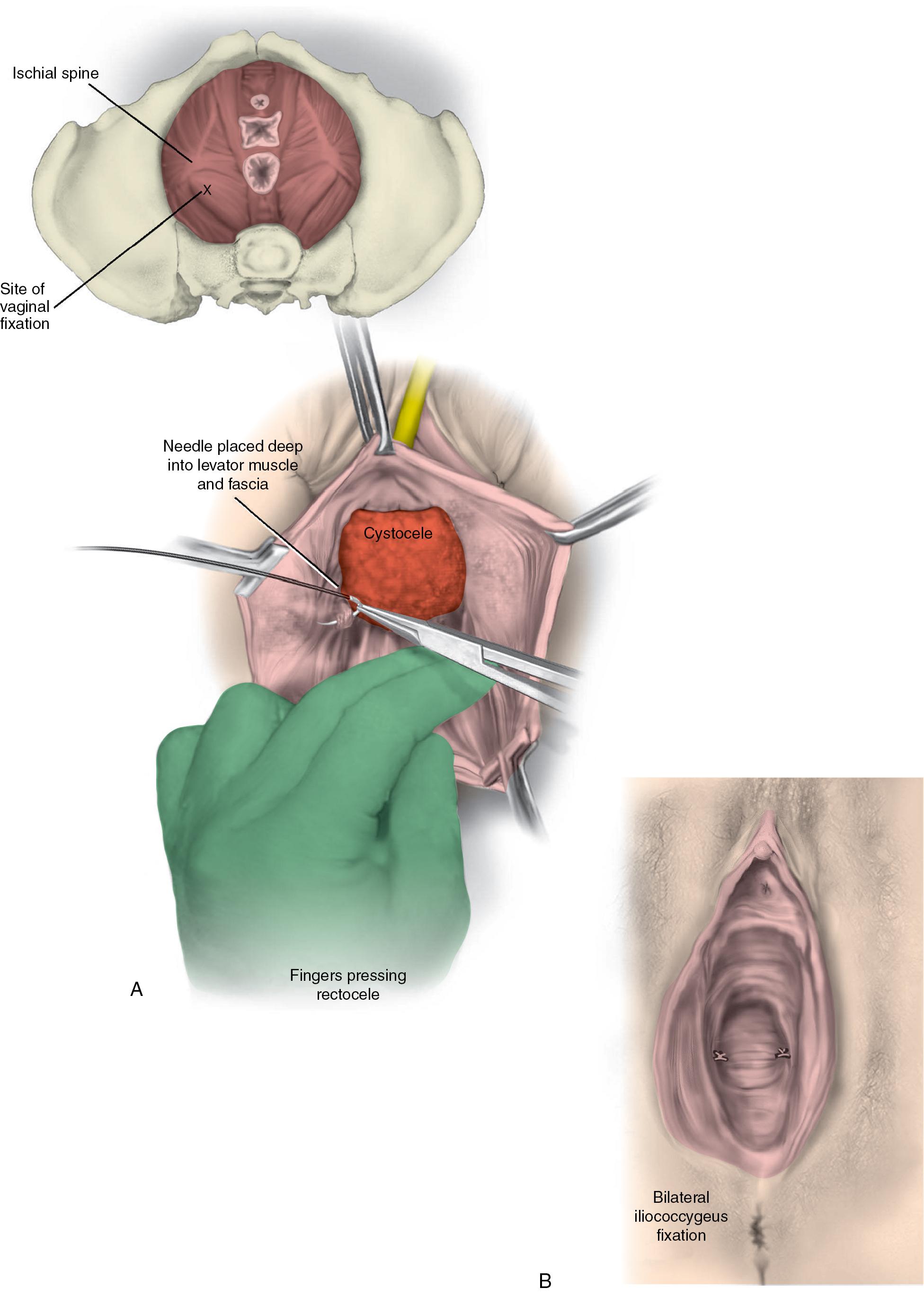
The posterior colporrhaphy is completed, and the vagina is closed. Both sutures are tied, elevating the posterior vaginal apices.
There are no randomized trials that support the use of this procedure. Several case series have provided some information. In a retrospective case-control study, reported similar subjective (91% vs. 94%) and objective (53% vs. 67%) cure rates with iliococcygeus suspension ( n = 50) compared with SSLS ( n = 78). A prospective cohort of 44 subjects receiving iliococcygeus suspension followed for a median of 68.8 (range 60–92) months provides the longest-term data on this procedure ( ). The rates of objective success (POPQ stage 0 or 1) and subjective success (patient global impression of improvement <2) were both 84%. Preoperative stage 4 vault prolapse was an independent predictor of failure (OR 8.8; 95% CI 1.3–9.4).
Become a Clinical Tree membership for Full access and enjoy Unlimited articles
If you are a member. Log in here